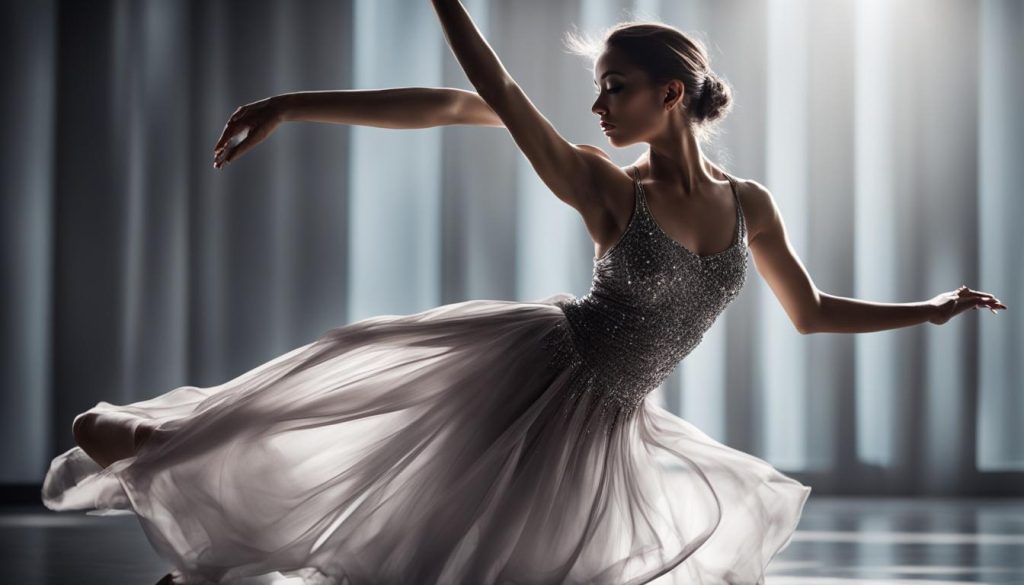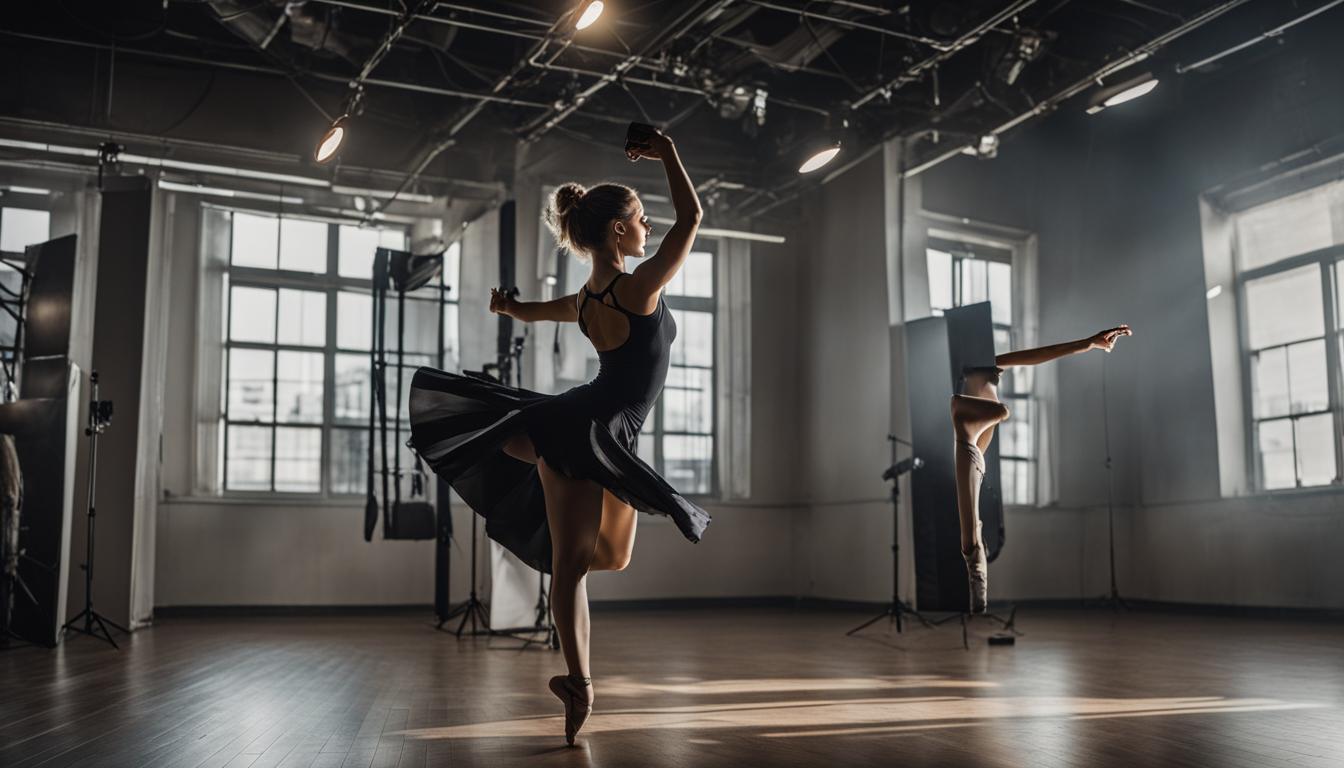Do you love capturing the beauty and grace of dance through photography? Whether you’re a professional photographer or a dancer looking to capture your movements, our ultimate dance photography checklist guide is here to help you. In this comprehensive guide, we will provide you with tips and tricks to help you capture every leap and twirl perfectly. Our checklist covers everything from choosing the right equipment to mastering lighting techniques and capturing stunning action shots.
Key Takeaways
- Our dance photography checklist guide provides tips and techniques for stunning dance shots every time.
- Choosing the right camera and lenses is crucial for capturing the grace and energy of dance.
- Creating a comfortable and professional studio environment is key to capturing breathtaking images.
- Properly understanding and utilizing lighting techniques can elevate your dance shots to the next level.
- Pose and composition play key roles in capturing the beauty and fluidity of dance movements.
Choosing the Right Camera and Lenses
If you’re an avid dance photographer, you know the importance of having the right equipment. The right camera and lenses can make all the difference in capturing stunning photos that showcase the grace and energy of dance.
When selecting a camera, there are a few important features to consider. Look for a camera with a fast continuous shooting speed to capture those quick movements. A high ISO range will help you shoot in low light conditions, while a wide dynamic range can help you capture detail in bright highlights and dark shadows.
As for lenses, prime lenses with a wide maximum aperture are ideal for dance photography. These lenses allow you to blur the background and isolate the dancer, creating a beautiful depth of field effect. Zoom lenses can also be useful for flexibility in framing your shots. For ballet and other types of dance that require a longer focal length, a telephoto lens is recommended.
Ultimately, the right camera and lenses for your dance photography will depend on your style and shooting needs. Consider renting different equipment to test out before making a purchase.
Recommended lenses for different types of dance:
- Ballet: 50mm prime lens, 70-200mm f/2.8 telephoto lens
- Jazz: 35mm prime lens, 85mm f/1.8 prime lens
- Contemporary: 24-70mm f/2.8 zoom lens, 50mm f/1.4 prime lens
Setting Up the Perfect Dance Photography Studio
If you want to capture stunning dance photographs, creating the perfect dance photography studio is crucial. Not only does it enhance the overall look and feel of your images, but it also lends a professional and comfortable environment for the dancers to perform.
Choosing the Right Space
When selecting the perfect space, you should consider the location, size, and environment. A spacious room with high ceilings is ideal to accommodate movements and offer more flexibility with your lighting and shooting positions. It should also have a clean and uncluttered background that does not distract the viewers.
Lighting Setups
The right lighting technique will lend an essential element to your dance images. You should take full advantage of natural light and supplement it with professional lighting equipment, such as umbrellas, reflectors, and strobes, to create stunning effects and shadows. Keep in mind that the color temperature of your light should match the overall look and theme of your shoot.
Backdrop and Props
Consider adding a backdrop or props to add some depth and interest to your images. You can use a plain white or black backdrop, or choose something more colorful to complement the dance movements and costumes. Props can be anything from ribbons, scarves, or even chairs, and they can provide a unique visual element to your shots.
Posing Aids
Having posing aids on hand can make the dancers feel more comfortable and confident while allowing you to capture the perfect shot. You can use anything from ballet barres to specially designed posing blocks or boxes that will help the dancers achieve specific poses and movements.
By following these tips on setting up the perfect dance photography studio, you can create a comfortable and professional environment that will enhance your dance photography sessions and ensure breathtaking dance shots every time.
Mastering Lighting Techniques
Lighting is a crucial element in enhancing dance photography. By properly utilizing lighting techniques, your dance shots can become truly stunning. There are several lighting setups to consider, such as natural light, studio lighting, and on-location lighting.
One of the most important lighting techniques to master in dance photography is manipulating light to highlight the dancers’ movements. This involves understanding how to position your lights to create shadow and depth, which can further emphasize the grace and beauty of the dancers’ motions.
Another lighting technique to explore in dance photography is backlighting. Placing a light behind your subject can create a beautiful glow around their movements. This is particularly useful during performances, where the light reflects off the dancers’ costumes to create a stunning and unique effect.
In addition to these lighting techniques, there are many other lighting tricks and tips to explore. The key is to experiment and determine the lighting style that works best for your desired shot or effect. By taking the time to master your lighting techniques, your dance photography can truly shine.
Posing and Composition Tips for Dance Photography

Pose and composition are essential in capturing the grace and beauty of dance. These elements play a significant role in creating impactful and visually appealing photos. Here are a few tips to help you get the perfect shot:
- Pay attention to the dancers’ lines: The poses should reflect the grace of the body movement
- Use Props: They can help to improve composition and enhance the overall mood of the image
- Work with different angles: Experiment from different angles to capture the dancers better
- Freeze moments: Freeze frames are perfect for capturing sharp and striking images that highlight the dancer’s motion
These are just a few examples of how you can improve your posing and composition. Keep on practicing, experimenting, and refining your skills, and remember that dance allows endless creative possibilities.
Techniques for Freezing Motion and Capturing Action Shots
Dance photography offers a unique opportunity to capture the grace and precision of dancers in motion. To freeze that movement and capture stunning action shots, it’s important to understand the right techniques and settings.
Shutter Speed
One of the most critical settings in dance photography is the shutter speed. To freeze motion and capture action shots, you need a fast shutter speed. Typically, you’ll want to set the shutter speed to at least 1/500th of a second, or faster, depending on the speed of the movement.
Focusing Techniques
When capturing fast-moving dance shots, you need to ensure your focus is crisp and clear. Many cameras offer different focusing modes, but using continuous autofocus (AI Servo on Canon cameras) is often the best choice for dance photography. This technique focuses continuously on the subject as they move, ensuring sharp images.
Other Camera Settings
Other camera settings that can help you capture stunning action shots in dance photography include burst mode and high-speed sync flash. Burst mode allows you to capture multiple images in quick succession, helping you capture just the right moment. High-speed sync flash allows you to use flash at high shutter speeds, making it ideal for low-light situations or for creating dramatic effects.
By mastering these techniques, you’ll be able to freeze motion and capture breathtaking action shots in your dance photography.
Conclusion
With our ultimate dance photography checklist, you’ve got everything you need to capture stunning dance photographs. Whether you’re a professional photographer or an enthusiastic dancer, our tips and tricks will help you showcase the beauty and energy of dance.
Remember to experiment with different techniques, practice often, and never stop learning. The art of dance photography is all about passion, patience, and creativity.
We hope our guide has been helpful to you. If you have any questions or feedback, feel free to reach out to us. Happy shooting!






